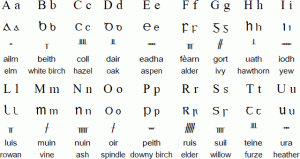Hello my wonderful readers,
There are many wonderful languages around the world. My absolute favorite, though, is Scottish Gaelic. A very hard language to learn, I know only a few phrases and words, unfortunately. 🙁
That’s why I decided to do some more research on it! Let’s learn about its history, phonology, and grammar! We can even learn a few more phrases, who knows!

Gaelic clock. Image source.
Origins
Based on medieval accounts, Scottish Gaelic has probably derived by the Irish Gaelic, or Old Irish. Settlers from Ireland founded, around the 4th century CE, the Gaelic Kingdom of Dál Riata on Scotland’s west coast in present-day Argyll. It was mostly spoken in the region, the rest of Scotland speaking Pictish, until the 8th century. During the reign of Caustantín mac Áeda (900–943), outsiders began to refer to the region as the kingdom of Alba rather than as the kingdom of the Picts, and by the 10th century Pictish appears to have become extinct, completely replaced by Gaelic.
Scottish Gaelic was (and still mostly is) spoken mainly in the Highlands (a’ Ghaidhealtachd) and in the Western Isles (Na h-Eileanan an Iar), but also in Glasgow (Glaschu), Edinburgh (Dùn Eideann) and Inverness (Inbhir Nis).
Decline
The decline of the Gaelic language happened some eons later, around 1000 CE, during the reign of Malcolm III. His wife, Margaret of Wessex, didn’t speak any Gaelic, gave her sons Anglo-Saxon names, and brought many English bishops, priests and monastics in Scotland.
When Margaret and Malcolm died, there was an effort to revive the Gaelic language by having his brother, Donald Bàn, as a monarch. Donald was the last Scottish monarch to be buried on Iona, the traditional burial place of the Gaelic Kings of Dàl Riada and the Kingdom of Alba.
However, during the reigns of Malcolm Canmore’s sons, Edgar, Alexander I and David I (their successive reigns lasting 1097–1153), Anglo-Norman names and practices spread throughout Scotland south of the Forth–Clyde line and along the northeastern coastal plain as far north as Moray. Norman French completely displaced Gaelic at court. The establishment of royal burghs throughout the same area, particularly under David I, attracted large numbers of foreigners speaking Old English. This was the beginning of Gaelic’s status as a predominantly rural language in Scotland.
Nowadays, Scottish Gaelic is said to be spoken by 87,100 people in Scotland. More specifically, 32,400 could understand, speak, read and write Gaelic, 57,600 could speak Gaelic, 6,100 could read and/or write Gaelic, but not speak it, and 23,400 could understand Gaelic, but not speak, read or write it. The Highlands, of course, are the areas that Gaelic is most often spoken.
A bit sad, that such a language would go almost extinct so easily, don’t you think?
General knowledge about the language
The Educational Act of 1872 in Scotland completely forbade people from speaking their native tongue. As late as 2001, people distinctly remember getting beaten up for speaking Gaelic at school. Human nature never changes, eh?
However, there are Gaelic-speaking people in Canada, particularly in Nova Scotia (Alba Nuadh) and Prince Edward Island. Other speakers can be found in Australia (Astràilia), New Zealand (Sealainn Nuadh) and the USA (Na Stàitean Aonaichte).
Scottish Gaelic didn’t have a lot of texts, since it was mostly oral tradition. The earliest identifiably texts in Scottish Gaelic are notes in the Book of Deer written in north eastern Scotland in the 12th century. collection of poetry in Scottish Gaelic, The Book of the Dean of Lismore (Leabhar Deathan Lios Mòir), was compiled in manuscript form in the early 16th century. Two prominent writers of the twentieth century are Anne Frater and Sorley Maclean.

Gaelic Alphabet. Image source.
The alphabet
Scottish Gaelic is written with 18 letters of the Latin alphabet. Traditionally each letter is named after a tree or shrub, however the names are no longer used. Inscriptions in Ogham have been found in Scotland, however it is not certain what language they are in. Some may be in Gaelic, others in Pictish. The Ogham equivalents of the Latin letters are shown below. The Gaelic Script is also shown, as it was used in Scotland, and is still used as a decorative script.
The connragan leathann or broad consonants are those preceded or followed by a, o or u. Connragan caola or slender consonants are those preceded or followed by i or e. Most consonants have different pronunciations depending on whether they appear at the beginning of a word or elsewhere.
Here is a sample text:
Rugadh na h-uile duine saor agus co-ionnan nan urram ‘s nan còirichean. Tha iad reusanta is cogaiseach, agus bu chòir dhaibh a ghiùlain ris a chèile ann an spiorad bràthaireil.
(Translation: All human beings are born free and equal in dignity and rights. They are endowed with reason and conscience and should act towards one another in a spirit of brotherhood.)
(Article 1 of the Universal Declaration of Human Rights)
What a wonderful meaning, written in the most wonderful language! Oh, how I wish I could speak Gaelic. Actually, you can learn some on Duolingo. How fun is that? 😀
Did you like this article, my dear? Would you learn Scottish Gaelic? Let me know in the comments!
Until next time…
Written by Maddie Mackenna

 Share this book
Share this book